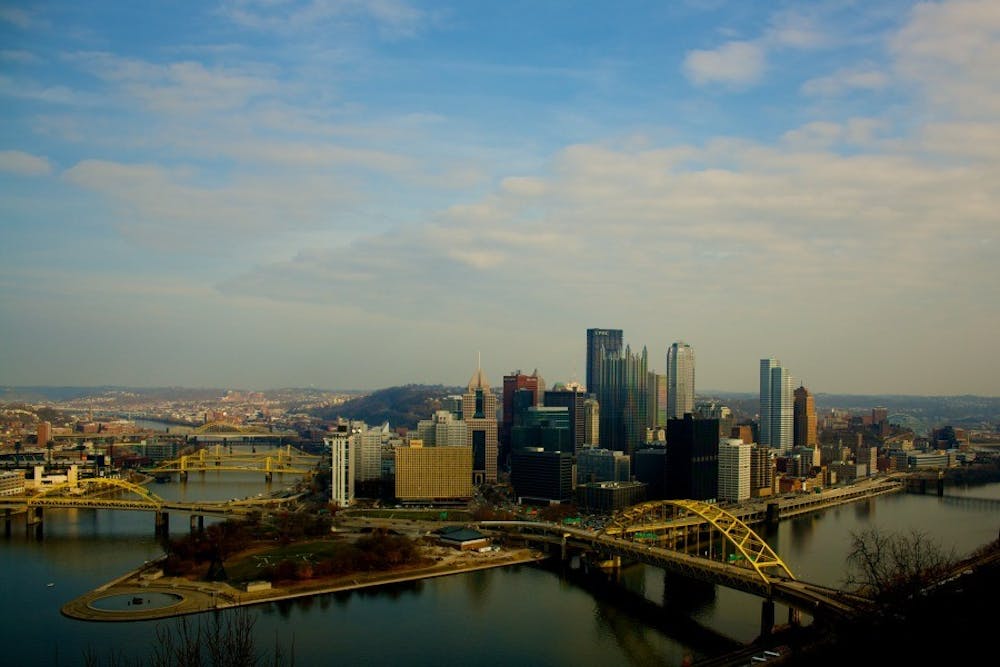By David Shoemaker, For The Miami Student
Being less than an hour away from the Indiana border at an Ohio public university, a Pittsburgher like me isn't usually surrounded by people from the "Steel City."
When people ask me where I'm from, I'd be lying if I said I don't get excited to respond with "Pittsburgh."
To many Miami students' ears, my answer is probably unique, as some acquaintances will ask me why I decided to come here. Due to it's small-town feel, I say "Pittsburgh" proudly with the hopes of meeting someone who also calls the "412" home.
Since Pittsburgh's world-famous steel industry began to collapse in the late 1970s, the city has had a population decline similar to fellow Rust Belt cities such as Detroit and Cleveland. Between 1980 and 2010, even after suburban sprawl took place in the 50s and 60s, these cities lost between 28 percent and 41 percent of their population.
More so than Pittsburghers themselves may realize, this "lost generation" of former steel mill workers has had a profound effect on our image. Since many union workers were uneducated and unskilled whites, they took any job with a paycheck when unemployment hit, which explains why 50-something-year-old white men have held jobs that might have attracted immigrants in other cities.
While cities like Toronto and Los Angleles became cultural bastions with immigrants from Asia and Latin America, Pittsburgh became a tight-knit predominantly blue-collar white community with a love for their sports teams and bar food. Consequently, stereotypes formed about people from "Sh!tsburgh" as economic opportunities and cultural awareness remained stagnant.
Whether it is Pittsburgh's title as the oldest U.S. metropolitan area or as having the ugliest accent, I have heard friends answer "Pittsburgh" in an embarrassed tone to the "Where are you from?" question. Contrasting this embarassement though are YouTube videos such as "Pittsburgh Dad" and the "The Dahntahn Song" that confirm how "yinzers," a "Pittsburghese" noun to describe its residents, have consciously embraced their far from hip tastes in food, fashion, and music. Growing up as the youngest of eight first cousins on my mom's side, I myself witnessed five of these eight leave the 'Burgh for work or college in cities such as Chicago and New York. As a result, these departures allowed me to experience the two world-class cities from a young age.
However, because of these visits along with vacations to Boston, Washington D.C. and Toronto, I too went through a phase of looking down upon the "yinzer" culture of Primanti Bros., Wiz Khalifa and sports obsession. I became sick of not having a Zara or Kanye West passing us up for Philadelphia on his tour. Honestly, I thought Pittsburgh was too old, white and conservative to ever be as cool as the cities I was lucky enough to visit.
However, things have begun to change for the city. For a younger me, right now is a good time to be a Pittsburgher.
On every side of the city, recently opened condominiums, restaurants and retail spaces are attracting hip liberal millennials to settle down in the "Most Livable City." Publications such as the Chicago Tribune and The Washington Post rave about Pittsburgh being the "new Portland."
Comparing the mustaches and off-brand beers of the two cities, they're right when noting that Pittsburghers aren't ironically drinking Iron City beer and keeping outdated facial hair. Many do both in earnest.
To be frank, the beauty of the current Pittsburgh is in this unique co-existence of remnants of the past and glimpses of the future.
While I can hang out in a hipster pinball machine parlor in the recently gentrified Lawrenceville, I can still enjoy a walk down Brownsville road through the Brentwood suburb and neighboring Carrick neighborhood, and admire the multitude of churches and mediocre pizza shops that still linger.
I can complain about the pothole-ridden streets while simultaneously praising Mayor Bill Peduto for those new bike lanes in East Liberty.
After eating a $50 dollar gourmet dinner that I can't even pronounce at Salt of the Earth in Garfield, I can still take a bus down Forbes Avenue for a $3.74 hot dog at The Original Hot Dog Shop, a greasy-floored "yinzer" favorite built in 1960.
If you can't tell, after leaving it, I have come to miss the aspects of Pittsburgh that I used to look down upon. Returning to the torn up roads, confusing traffic lanes and plethora of bridges for fall break made me realize something: I don't want Pittsburgh to be the "new Portland."
As much as I want Pittsburgh to become younger, progress its politics and diversify its population, I don't want that to come at the cost of pretentious outsiders corrupting the 'Burgh's humble small-town feel that stems from it's blue-collar past.
I know I might be irrationally relishing in an irretrievable past, but it's really difficult to successfully replace nostalgic yet charming row houses with steel and glass high-rises.
So yes, I know the city has its quirks and old-fashioned tendencies but no more than my great aunt's mannerisms. In both cases, I've come to keenly appreciate them because they're still family and I'll love them no matter what.

